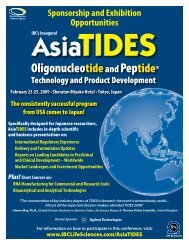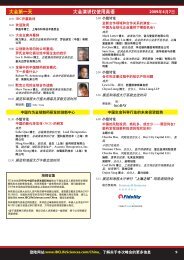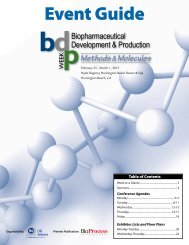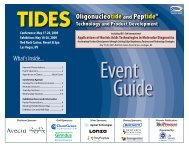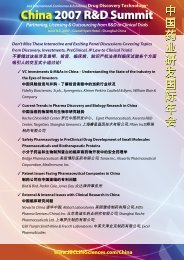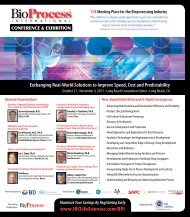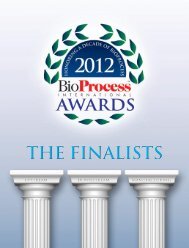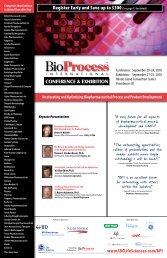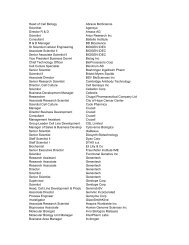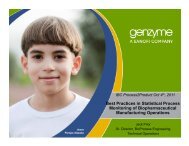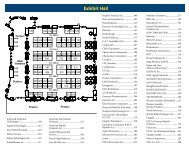Main <strong>Conference</strong> • Thursday, <strong>October</strong> 4, <strong>2007</strong> (continued)Cell Culture & Upstream ProcessingRecovery & Purification3 410:45 Topic and presenter to be determined11:15 The Application of Root Cause Analysis andInvestigational Tools to Identify and Resolve CellCulture Issues Observed at Commercial Scale duringTechnology TransferUnexpected cell culture performance was observed during the transfer and scaleup of a commercial scale process to 15,000L. This presentation discusses theapplication of root cause analysis and investigational tools to identify and resolvethe process issues. The investigational tools include multivariate data analysis,computational fluid dynamics, bench and pilot scale evaluation.Kenneth Green, Ph.D., Principal Scientist, Amgen Inc.11:45 Concurrent Technology WorkshopsNext Generation Process Control10:45 A Systematic Approach for Process Improvementvia Process Data Analysis: Example for ImprovingUFDF Recovery EfficiencyCaseStudyIn a biological manufacturing process, a large number of process variables are typicallymonitored. These data can be used to increase process efficiency and improve stability.In this work, an approach is presented to systematically analyze process data forimproving the efficiency and operation consistency of an ultrafiltration/diafiltration(UFDF) process step which is used to concentrate a purified protein product.Michael J. Bartkovsky, Ph.D., Process Engineer, BioPharma Group, BayerTechnology Services, Bayer Corp.11:15 Process Characterization during Development and ValidationDriven by competitive and regulatory compliance demands, there is increasingemphasis to optimize including process identification, process validation, processcontrol, and process improvement throughout process development. Thispresentation describes statistical techniques that are used to identify critical processcharacteristics. Topics include design of experiments and analysis of variance.Steven Walfish, M.S., President, Statistical Outsourcing ServicesProcess Optimization Using Peptones – CaseStudies Demonstrating Increased PerformanceWith Peptone Blends and Feed StrategiesOne of the most important factors in any production processis the selection of an appropriate base medium that is coupledwith an effective feed strategy. Animal Free peptones havebeen successfully used to achieve increased production levelswith minimal cost and timeline requirements. Several casestudies will be shown in this presentation where significantproduction improvements were achieved through the use ofpeptone blends or an appropriate peptone feeding strategy.Stacy Holdread, M.S., Senior Scientist, R&D, BDBiosciences – Advanced BioprocessingAbstract and speaker nameunavailable at press time.Please visit www.<strong>IBC</strong><strong>Life</strong><strong>Sciences</strong>.com/BP/USfor program updates.Preview of a Novel and Robust Viral Clearance Solutionfrom MilliporeThis workshop will provide a preview of Viresolve® Pro, a novel virus clearancesolution under development at Millipore. It combines a high capacity/highflux virus filter with a high level of parvovirus retention and novel intergritytesting technology. Case studies will be presented, with virus clearance resultsthat demonstrate the anticipated performance of Viresolve Pro devices. Thisinformation is critical for process development scientists and manufacturingengineers who are looking for effective and efficient virus clearance solutions.Inese Lowenstein, Group Product Manager, Virus Clearance, Bioprocess R&D,Millipore CorporationMani Krishnan, Program Manager - Virus Clearance, Bioprocess R&D,Millipore CorporationSal Giglia, R&D Manager, Bioprocess R&D, Millipore Corporation12:15 Luncheon and Technology WorkshopSponsored by:Integration, Implementation and Validation of Single-use Bioprocessing TechnologiesSingle use disposable technology is a proven alternative solution for the biopharmaceutical industry (upstream, downstream, formulation and filling) offeringseveral significant advantages over standard reusable stainless steel systems. Key factors for successful single use system integration are: Process Knowledge,Experience with Single Use Systems, Single Use Product Portfolio offering, Strong Technical Capability, Full Documentation Package, Validation SupportMonica Cardona, Marketing Manager, Pall <strong>Life</strong> <strong>Sciences</strong>Cell Culture & Upstream ProcessingRecovery & Purification3 41:30 Chairperson’s RemarksSuzanne Kuo, Ph.D., Senior Engineer, Late Stage Cell Culture ProcessDevelopment, Genentech, Inc.Commercial Process Readiness, Troubleshootingand Improvements1:45 BioProcessing Challenges for Large ScaleDisposable BioreactorsDisposable bioreactors have been shown to be effective in performing batch,fed-batch and continuous cell culture processes. At large scale, the traditionaland expected challenges arise such as oxygen transfer, CO2 removal andadequate mixing time for addition of nutrients and pH control fluids. Large scaleperfusion operation presents the most extreme challenges including volumecontrol, steady feed addition, harvest removal, cell recycle and maintenance ofsterile operations in a more complex large scale system. The presentation willhighlight these challenges at large scale and will present data from a case study.Jin Yin, Senior Bioengineer, Shire Human Genetic Therapies, Inc.Geoffrey Hodge, Vice President, Process Development and Technology,Xcellerex Inc.1:30 Chairperson’s RemarksChris Dowd, Ph.D., Senior Engineer, Late Stage Purification, Genentech, Inc.Novel Process Development Strategies1:45 Process Development Strategy for High-Concentration UF/DF of MAbsProducing antibody products formulated at high concentrations is useful todeliver adequate product in small injection volumes. However, at large scalethis may be a challenge. In this presentation we will describe a well-definedexperimental approach to optimizing and scaling up the ultrafiltration/diafiltration step for the concentration and formulation step used inmanufacturing processes to produce antibody products. We have developeda robust, scalable UF/DF step that allowed us to produce clinical supplies atproduct concentrations up to approximately 125 g/L of protein. We will alsoshare observations made during the development of the diafiltration step.The experimental results for diafiltration will be presented along with theexpected theoretical trends and values for pH, conductivity, osmolarity, andconcentrations of components in the diafiltration buffer.Robert G. Luo, Ph.D., Senior Scientist, Purification <strong>Sciences</strong>, Human Genome<strong>Sciences</strong>, Inc.18 Visit www.<strong>IBC</strong><strong>Life</strong><strong>Sciences</strong>.com/BPI/US for up-to-date information on this event
Main <strong>Conference</strong> • Thursday, <strong>October</strong> 4, <strong>2007</strong> (continued)Cell Culture & Upstream ProcessingRecovery & Purification3 42:15 Comparisons of Product Quality from Disposable andStainless ReactorsAbstract unavailable at press time. Please visit <strong>IBC</strong><strong>Life</strong>Science.com/BPI/USfor updates.Sadettin Ozturk, Ph.D., Head, Bioprocess Technology, Centocor, Inc.2:45 Efficient Cell Culture Characterization and ValidationStudies Using a Scale-down Model for Changes to aLicensed Antibody ProcessFor a previously licensed antibody process, several process changeswere implemented. These changes required the completion of newcharacterization and validation studies. As part of the characterizationexercise, a scale-comparability assessment was performed on small-scale andpilot-scale models. Results from this study will be presented. In addition,several strategies developed to reduce the number of test cases and toincrease the efficiency of the characterization/validation exercise will bediscussed. By determining an appropriate scale-down model and performingthorough characterization and validation studies, post-approval processchanges were supported in an efficient manner with confidence in keyproduct quality attributes.Marion Piquet, Engineer I, Late Stage Cell Culture, Genentech, Inc.3:15 Networking Refreshment Break3:30 A Custom Developed Integrated Bioreactor CaseControl and Data Management System for StudyProcess Development – Leveraging Information fromEarly Stage Process Development through CommercialManufacturingOur case study represents a custom developed bioreactorSCADA(Supervisory Control and Data Acquisition) system and theassociated data management architecture to achieve the following objectives:improve process consistency, reliability of information, and productivity.A new strategy was implemented whereby available commercial controlsystems were customized for both development and GMP areas.Nicole Bleckwenn, Ph.D., Scientist II, Process Cell Culture & Fermentation,MedImmuneMichael Gammons, Associate Director, Development Information Systems,MedImmune4:00 Characterization of the Operating Parameters for theWAVE Bioreactor Expansion Stages of a CommercialScale Cell Culture Production ProcessWAVE Bioreactor technology was implemented in the cell cultureexpansion stages of a commercial production process. Operating parameterswere characterized using a Design of Experiments approach. Worstcaseconditions were identified and evaluated to determine recoveryin subsequent expansion stages. Experimental results led to operatingparameter classification based on the significance to process performanceover the characterized range. Bench and full-scale data was utilized to setacceptance criteria for monitoring process performance. Characterizationdata supporting the process scale-up will be presented.Carin Gray, Associate Scientist, Cell <strong>Sciences</strong> and Technology, Amgen Inc.4:30 Data Mining with Avastin® for ProcessImprovements and OptimizationCaseStudyAvastin® (bevacizumab) was approved in 2004 as the first therapydesigned to inhibit angiogenesis. With product growth and evolution hascome the need to align manufacturing capacity and product demand,thereby creating opportunities to improve yield, reduce cost, andincrease efficiency. This talk highlights Genentech’s approaches to miningmanufacturing data and driving such opportunities while sustainingmanufacturing process governance.Eric Fallon, Ph.D., Associate Director, Manufacturing <strong>Sciences</strong> andTechnology, Genentech, Inc.5:00 Close of <strong>Conference</strong>2:15 Accelerating Process Development: Automation ofAnalytical AssaysThe development of a protein or vaccine purification process is guided by theanalysis of samples from trial purification processes, which define processperformance. A variety of quantitative assays are used to monitor the clearanceof contaminants and excipients, and to determine the recovery and quality of thetarget biomolecule. A strategy is presented which enables complete automationa variety of process monitoring assays, from sample preparation through to datareduction and data reporting. This strategy uses commercially available robotichardware and software, augmented by a custom user interface developed usingMicrosoft Excel with Visual Basic for Applications. The interface adds the abilityto dynamically program the robotic systems, and is also structured to collect andmanage raw data, calculations, and the reporting of results. This approach has beenused to automate a variety of assay formats, such as colorimetric, dye-binding,specific protease and nuclease activity assays, fluorescence polarization assays,antigen-binding, and ELISAs. The design and function of these automated systemsis discussed here, along with the routine operation in an automated assay lab.Peter DePhillips, Ph.D., Director, Bioprocess and Bioanalytical Research,Merck and Co.2:45 Exploring “Hot Spots” In Recombinant MonoclonalAntibody MoleculesPost-translational modifications during synthesis and additional chemicalmodifications during production and storage add to molecular heterogeneityof recombinant monoclonal antibodies. This presentation will focus on howglycosylation, cysteinylation, and methionine and tryptophan oxidation mayor may not affect structure, in vitro activity, stability, and/or in vivo behaviorof monoclonal antibodies.Yuefeng Lu, Ph.D., Principal Scientist, Global Process Engineering, Amgen Inc.3:15 Networking Refreshment Break3:30 Humira After Launch – Opportunities and Challenges inDownstream ProcessHumira (Adalimumab) was successfully launched in 2002 and is currentlymanufactured at both 3,000L and 6,000L scales. During the past years ofmanufacturing, there has been a continuous effort to: (1) increase processrobustness and ensure high quality, (2) satisfy and harmonize divergent globalregulatory demands, and (3) ensure that an identical process could be launchedat the 12,000L scale. First generation process improvements were developed in2003 and implemented in 2004 to improve process robustness and harmonizethe processes at different scales. Process mapping studies were undertaken laterto refine our knowledge of process attributes like intermediate purity, yield andthe dynamic performance of each unit operation. As a result, a fine-tuned revisedadalimumab downstream process is currently approved for both 6000L and12000L scales. Data from at scale validation demonstrating improved productquality, HCP clearance, and yield will be presented.Diane D. Dong, Ph.D., Senior Scientist, Technical Operations,Abbott Bioresearch Center4:00 Use of Complex Analytical Methods to Support ProcessDevelopmentOver the past few years, significant advances have been made in complexanalytical technologies, including capillary electrophoresis and massspectrometry. These techniques routinely allow for a rigorous evaluationof the biochemical characteristics of therapeutic proteins and have provenindispensable to successful development of robust manufacturing processes.In this presentation, we will discuss potential applications of selected analyticaltools, and how and where they may be best used to support process development.Daotian Fu, Senior Director of Analytical Development, Genzyme Corporation4:30 Evaluation of Conformation and Bioactivity of aMonoclonal Antibody Product as a Function of Timeand pH Following Protein A ChromatographyEvaluation of process design space throughout development and commercialmanufacturing of a monoclonal antibody product provides improved understandingof the effects of processing conditions on conformation and bioactivity of theproduct. Such increased understanding has the potential to be used for bothnonconformance investigations and justification of process improvements.Paul Baptiste, M.S., Senior Process Scientist, Purification Technology,Centocor (GBSC)5:00 Close of <strong>Conference</strong>19 To Register, Call: (800) 390-4078 • Fax: (941) 365-0104 • E-mail: reg@ibcusa.com





